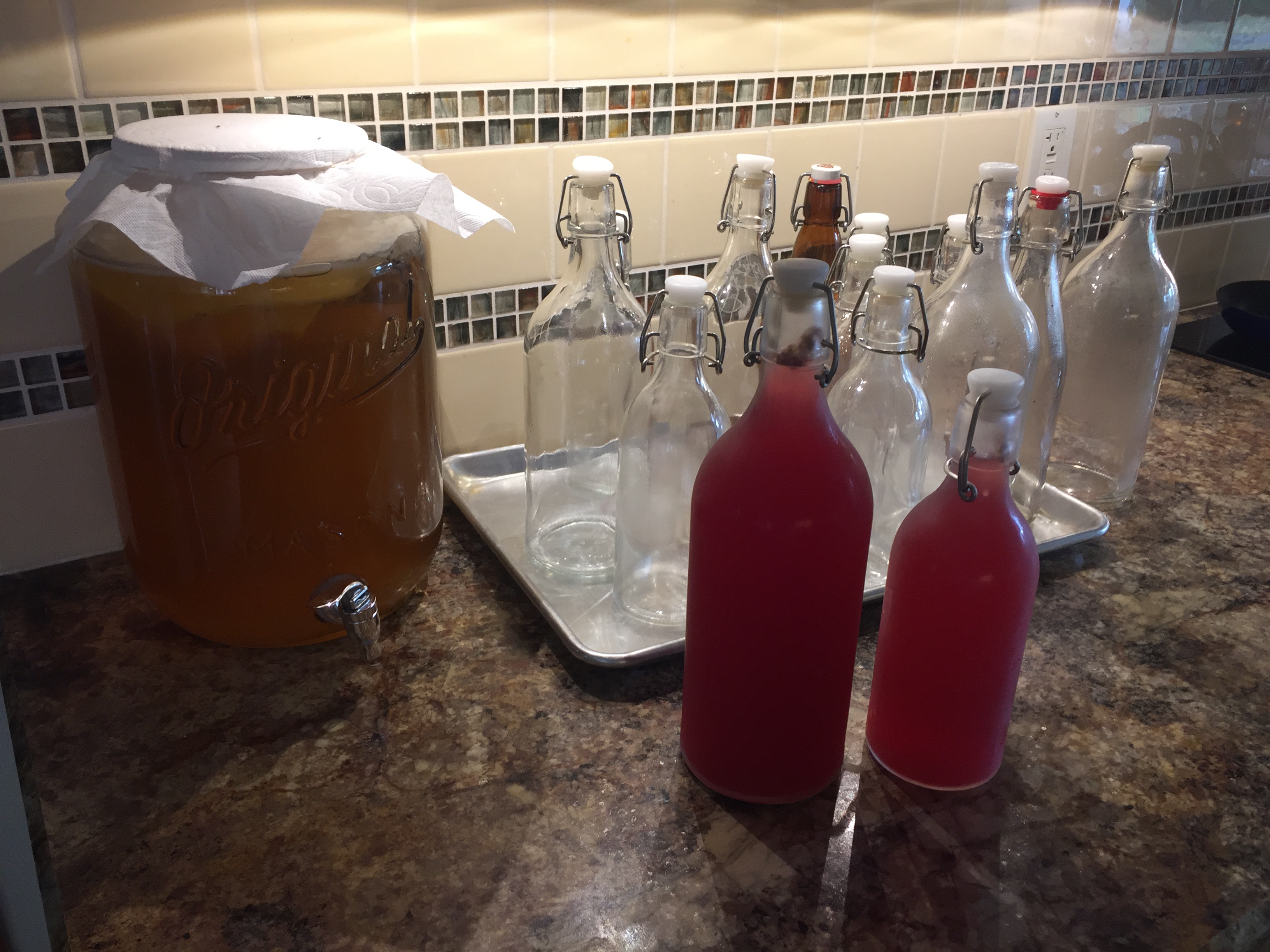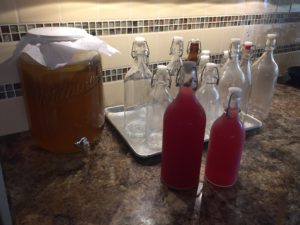For primary fermentation I use a 7-liter approx. 2-gallon tea jar, with a spigot near the bottom. Obtained from Bed Bath & Beyond, etc.
Do not put a tight-fitting lid on the jar. I cover the top with a paper towel, secured with a rubber band to let air in and keep everything else but kombucha out.
This batch size is about double the batch size of many/most of the recipes I see on the internet, which are about one gallon.
 |
| Tea jar for primary fermentation, bottles waiting to be filled, and bottles with finished kombucha from the previous batch |
Now days I use just about any “swing top” or Grolsh-type bottles. I “download” from the tea jar into the bottles. I generally get 5 or even 6 liters of bottled tea per batch. I have about a ten liter fleet of swing-top bottles that I got from IKEA and from on-line, probably Amazon. The bottles are durable and contain the fizz!
For some time now I have been going to at least eight days primary and four days secondary. After the primary fermentation, I allow three or four more days for secondary sedimentation at room temperature, then the bottles of kombucha may be chilled. I put the bottles in the refrigerator because the faster fermentation process at room temperature may let the bottles ferment too far with messy results.
If you are just starting your first batch, start here:
Making the Tea
- 16 – Tea Bags. I have switched to green tea as my personal preference. Feel free to experiment, with kombucha. There is a lot of room for error. Winco Tea Bags also work just fine. Green tea makes a lighter-colored product and the flavor of the tea doesn’t interfere with the fruits and spices. I just don’t happen to own one of those tea-balls or I would try bulk tea.
- 2-1/4 cups sugar, for my above-referenced tea jar, per batch for primary fermentation
- Water: For making the tea I use as much as my biggest pot can comfortably hold.
As the water comes to boil, add the sugar and dissolve it, then throw in the tea bags.
After 4 to 5 minutes, take out the tea bags. Let the tea cool until it is below a temperature that will not kill the SCOBY. I don’t know what temperature that would be, so let’s say room temperature or lukewarm. Time to cool to room temperature for 2 gallons at near boiling: overnight.
Pour the cooled tea into the jar, plus the SCOBY, at least one to two cups of starter tea, and enough water to fill to the neck of the jar. Starter tea may come from your previous batch or any unpasteurized or whatever kombucha you have.
After the 7 or 8 day initial fermentation, take the SCOBY out of the jar with your clean hand or glove and put it into a container to save for the next batch. Then pour about 2 cups of the now-fermented kombucha on the SCOBY, cover, and set aside to start the next batch.
After the jar settles down most of the “organic characteristics” of the brew will have either sunk or floated. So I think I get pretty good kombucha, even though it is unfiltered. Natural kombucha will probably always have a sediment and few strands of primordial SCOBY floating around.
I place a paper towel secured by a rubber band to keep all kinds of contaminants out. I use fresh paper towels every batch in an effort to keep everything clean. Wait seven or eight days and begin the bottling process .
Bottling Day
After the seven- or eight day primary fermentation period it is time to bottle.
Have your bottles ready to go. They should be absolutely clean and sterile.
First, with clean hands, reach into the jar and take out the SCOBY and put it into a two- to four-cup container (with tight lid. I use a Rubbermaid “TakeAlong”). Add about two additional cups of kombucha from the jar, to the container. This is the “starter.”
This is the point where flavoring, and more sugar, is added for the secondary fermentation process. Berries, spices, honey, or fruit juices can be added. The simplest recipe I have found is just to add about 2-1/2 cups of grape juice. This much juice is equivalent to about 1/2 cup of sugar. Originally, I used Costco concord grape juice. Costco quit selling grape juice so I went to Trader Joe’s. Then they quit selling grape juice so now I get it at Winco. It is important to not use anything that would stop the fermentation process, so anything with a preservative should not be used. Another easy flavoring is about 2 cups of blueberries and about 1/2 cup of sugar. Boil, mash, strain, and pour into the jar. There are many recipes on the internet that use turmeric, ginger, and all kinds of spices and fruits.
During the fermentation process sediment will accumulate on the bottom of the jar – fruit fiber and yeast. There will also be particles floating around, as well as the SCOBY (usually) floating on top. You can decide how to strain the kombucha when you bottle it. I don’t. I carefully fill the bottles, and carefully pour my glass with the finished product, with a minimum of disturbance.
It doesn’t hurt to consume the yeast, bits of fruit fiber, or SCOBY, but some people don’t like to. Some people don’t even eat bread crust. This is personal preference. I carefully drink unfiltered kombucha because I haven’t found an easy and effective way to strain it.
Fill the bottles from the spigot on the side of the jar. When you get down to the dregs, you are done bottling this batch. Pour it out, wash it out with plain water. Never contaminate the inside of the jar with anything but kombucha.
After three or four days, just put these newly-filled bottles in the refrigerator and enjoy.
Use only plastic, glass, or ceramic containers. No metal.
